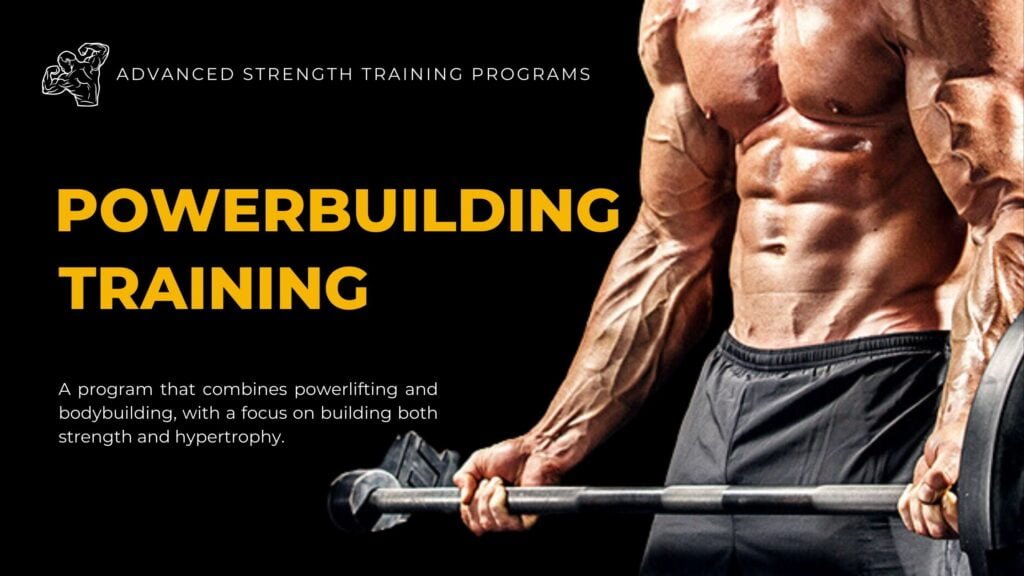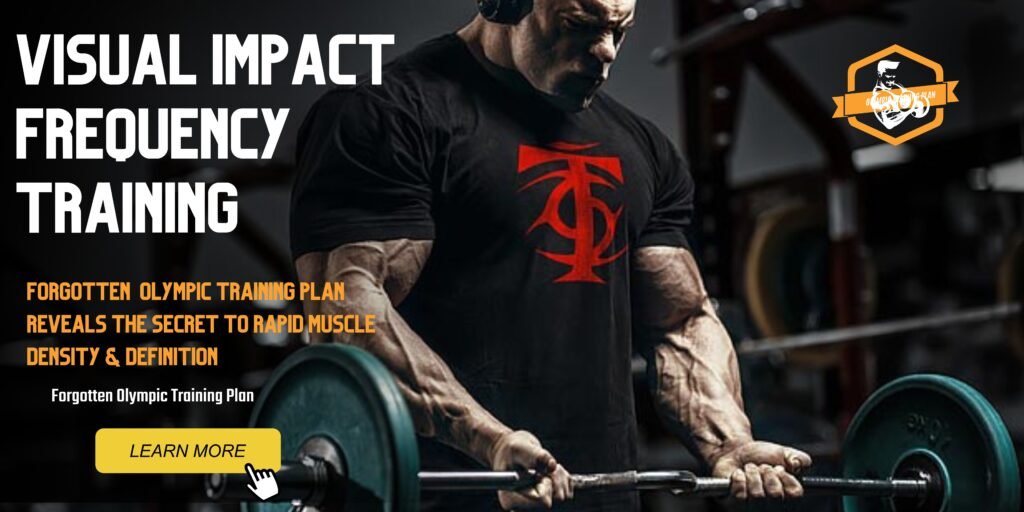Table of Contents
ToggleIntroduction
Powerbuilding training is a dynamic training method that merges the principles of powerlifting and bodybuilding to help individuals achieve their fitness goals. By combining heavy compound lifts, such as deadlifts, bench presses, and squats, with targeted accessory exercises, powerbuilding enables individuals to build both strength and muscle mass effectively. In this article, we will explore the benefits of powerbuilding training, how it differs from powerlifting and bodybuilding, common powerbuilding exercises, structuring a powerbuilding workout routine, and tips for modifying a powerbuilding program to achieve specific goals. Whether you’re a beginner or an experienced lifter, powerbuilding offers a versatile and effective approach to enhance your physical prowess.

Summary:
- Powerbuilding training combines powerlifting and bodybuilding for optimal strength and muscle gains.
- Benefits include improved strength, increased muscle mass, versatility, and improved work capacity.
- Powerbuilding training differs from powerlifting and bodybuilding in training focus, exercise selection, rep ranges, goals, and time commitment.
- Common powerbuilding exercises include squats, bench press, deadlifts, rows, and more.
- Structuring a powerbuilding training program involves incorporating compound exercises, modulating rep ranges, and customizing routines.
- Tips for modifying a powerbuilding training program for specific goals include identifying the goal, focusing on compound exercises, adjusting rep ranges and volume, incorporating accessory exercises, and customization.
- Cardio or conditioning can be integrated into a powerbuilding program, but balance is crucial.
- Potential drawbacks and risks include the risk of injury, heart health concerns, overtraining, limited sport-specific training, and potential muscle imbalances.
- SARMs alternatives can be considered but should be approached with caution.
- Results from a powerbuilding program can vary but are typically seen within a few weeks to a few months.
- Balancing powerbuilding with other types of training and considering individual factors is important for success.
How To Get Bigger & Stronger At The Same Time (Powerbuilding Science Explained)
The Benefits of Powerbuilding Training
Powerbuilding training offers several key benefits, including:
1. Improved Strength: Powerbuilding places emphasis on heavy weightlifting and compound exercises such as deadlifts, bench presses, and squats. These exercises target multiple muscle groups, resulting in overall strength gains.
2. Increased Muscle Mass: With its focus on both strength and muscle growth, powerbuilding training routines are highly effective for bodybuilding purposes, facilitating the development of lean muscle mass.
3. Time-Efficiency: Powerbuilding routines typically require less time compared to traditional bodybuilding workouts, making them an efficient option for individuals with busy schedules.
4. Versatility: Powerbuilding training routines can be tailored to meet individual training goals and skill levels. They can also be customized to include skill-based movements within accessory segments, allowing for versatility and a well-rounded training approach.
5. Improved Work Capacity and Resilience: Powerbuilding routines help enhance work capacity and resilience, making them particularly beneficial for functional fitness athletes.
6. Fat Loss: Powerlifting, due to its heavy lifting nature, can induce a high-intensity burn throughout the body, enabling individuals to burn a significant amount of calories and fat. Over time, powerlifting can also increase metabolic rate, contributing to long-term fat loss.
Powerbuilding serves as an effective means to build both strength and muscle mass while enhancing lifting performance. Its versatility and customization options make it suitable for various training goals and skill levels.
How Powerbuilding Training Differs from Powerlifting and Bodybuilding
Powerbuilding training program differs from both powerlifting and bodybuilding in several ways:
1. Training Focus: Powerlifting prioritizes maximal strength, especially in movements like the squat, bench press, and deadlift, while bodybuilding places greater emphasis on maximizing muscle hypertrophy. Powerbuilding combines elements of both, focusing on strength gains and muscle growth.
2. Exercise Selection: Powerlifting routines primarily revolve around the three main compound lifts: deadlifts, bench presses, and squats. In contrast, bodybuilding routines involve a broader range of exercises, targeting both large and small muscle groups through isolation and compound movements. Powerbuilding incorporates both compound lifts and accessory movements to target specific muscle groups effectively.
3. Rep Ranges: Powerlifting routines typically employ lower rep ranges with heavier weights, whereas bodybuilding routines utilize higher rep ranges with lighter weights. Powerbuilding routines encompass a combination of both lower and higher rep ranges to optimize both strength and muscle growth.
4. Goals: Powerlifting and bodybuilding are competitive sports with specific performance goals, while powerbuilding focuses more on individual training goals and skill levels.
5. Time Commitment: Powerlifting and bodybuilding routines can be time-consuming due to their rigorous nature, whereas powerbuilding routines are relatively shorter and more time-efficient.
Powerbuilding offers a unique blend of powerlifting and bodybuilding techniques, allowing individuals to concurrently build strength and muscle mass while catering to their specific training goals and skill levels.
Common Exercises in Powerbuilding Training
Powerbuilding training program , as a combination of powerlifting and bodybuilding, incorporates various exercises that target strength and muscle growth. Some common exercises found in powerbuilding routines include:
- Squat
- Bench press
- Deadlift
- Barbell rows
- Overhead press
- Leg press
- Leg curls
- Calf raises
- Pull-ups
- Dumbbell curls
- Dumbbell flyes
- Lateral raises
- Tricep pushdowns
- Skull crushers
These exercises serve as the foundation of a powerbuilding routine. The goal of each training session is to lift heavy loads within a lower rep range, typically around 4 to 6 reps per set.
Structuring a Powerbuilding Workout Routine
To structure an effective powerbuilding training workout routine, consider the following tips:
- Incorporate Compound Exercises: Integrate compound exercises such as squats, bench presses, and deadlifts, as they work multiple muscle groups and allow for heavier lifting.
- Modulate Rep Ranges and Volume: To maximize training sessions, adjust rep ranges, sets, and total volume on a semi-weekly basis.
- Include Power and Hypertrophy Days: Allocate specific days for power-focused workouts with lower reps and higher weights, and hypertrophy-focused workouts with moderate weights and higher reps.
- Include Rest Days: Rest days are crucial for recovery and muscle growth. Plan for one or two rest days per week.
- Customize the Routine: Customize your powerbuilding training program to align with your individual goals and skill level. Incorporate a variety of exercises, sets, rep schemes, and training intensities to meet your specific needs.
Here’s an example of a 5-day training routine:
Day 1: Upper-Body Power Day
- Bench Press: 4 sets x 6 reps
- Barbell Row: 4 sets x 6 reps
- Overhead Press: 4 sets x 6 reps
- Pull-Ups: 3 sets x 8 reps
- Dumbbell Curls: 3 sets x 8 reps
Day 2: Lower-Body Power Day
- Squat: 4 sets x 6 reps
- Deadlift: 4 sets x 6 reps
- Leg Press: 4 sets x 8 reps
- Leg Curls: 3 sets x 10 reps
- Calf Raises: 3 sets x 10 reps
Day 3: Rest Day
Day 4: Chest, Shoulders, and Triceps Hypertrophy Day
- Incline Dumbbell Press: 3 sets x 10 reps
- Dumbbell Flyes: 3 sets x 10 reps
- Lateral Raises: 3 sets x 10 reps
- Tricep Pushdowns: 3 sets x 10 reps
- Skull Crushers: 3 sets x 10 reps
Day 5: Lower-Body Hypertrophy Day
- Leg Press: 3 sets x 12 reps
- Leg Extensions: 3 sets x 12 reps
- Romanian Deadlifts: 3 sets x 12 reps
- Seated Calf Raises: 3 sets x 12 reps
- Abdominal Crunches: 3 sets x 15 reps
Remember, this is just an example, and you can customize your training program routine according to your specific needs and goals.
Incorporating Cardio or Conditioning into a Powerbuilding Training Program
To incorporate cardio or conditioning into a powerbuilding program, consider the following options:
- Sprinting: Include sprinting exercises in your routine, as they can help condition your body for short bursts of explosive activity.
- Tempo Interval Circuits: Powerbuilding training allows for hybrid training methods, such as “tempo interval circuits,” which involve alternating 20 to 45 seconds of steady-state activity (e.g., rowing, stationary biking, sled dragging) with 10 to 15 reps of accessory exercises.
- High-Intensity Interval Training (HIIT): Incorporate HIIT, which involves short bursts of high-intensity exercise followed by rest periods. HIIT can improve cardiovascular fitness and facilitate fat burning.
- Conditioning Exercises: Integrate conditioning exercises like sled pushes, prowler pushes, and farmer’s walks to improve work capacity and resilience.
However, it’s important to note that excessive cardio or conditioning can interfere with the primary goal of powerbuilding, which is building strength and muscle mass. Balance is key to avoid overtraining and optimize results.
Potential Drawbacks or Risks of Powerbuilding Training
While powerbuilding training offers numerous benefits, it’s essential to consider potential drawbacks and risks, including:
- Increased Risk of Injury: Powerlifting movements require proper technique and form. Incorrect execution can lead to a higher risk of injuries.
- Heart Health Concerns: Powerlifting can potentially impact heart health, increasing the risk of high blood pressure and heart disease.
- Overtraining: Intense powerbuilding programs can lead to overtraining and burnout if not managed properly. Adequate rest and recovery are crucial.
- Limited Sport-Specific Training: Powerbuilding may not focus extensively on sport-specific movements, which could be a drawback for athletes requiring specific skill sets.
- Potential Muscle Imbalances: Powerbuilding routines may not evenly target all muscle groups, potentially leading to muscle imbalances and an increased risk of injury.
To minimize these risks, ensure proper form and technique, gradually increase intensity, prioritize rest and recovery, and listen to your body to avoid overtraining.
SARMs Alternatives for Powerbuilding
While SARMs (Selective Androgen Receptor Modulators) are not recommended due to potential health risks, there are SARMs alternatives that individuals can consider for powerbuilding. Some popular options include:
- Osta 2866: A legal SARMs alternative designed to mimic the effects of Ostarine MK 2866, promoting muscle growth.
- Andarine: A versatile SARMs alternative that offers drier and harder muscle gains.
- C-Dine 501516 (Cardarine GW501516): Ideal for cutting cycles, this SARMs alternative helps increase muscle strength and mass.
- Ligan 4033 (Ligandrol LGD-4033): This SARMs alternative promotes protein synthesis, contributing to muscle anabolism and reduced muscle wasting.
- Ibuta 677 (Ibutamoren MK 677): An alternative SARMs option for enhancing strength and stamina.
- S-23 – Osta 2866 (Ostarine MK-2866): A recommended alternative for significant muscle growth.
- Stena 9009 (Stenabolic SR9009): Suitable for melting excess body fat while maintaining muscle mass.
Remember to conduct thorough research and consult with professionals before considering any supplementation, including SARMs alternatives.
Timeframe for Seeing Results from a Powerbuilding Training Program
The time required to observe results from a powerbuilding program varies depending on several factors, including individual goals, training intensity, and consistency. However, most individuals can expect to see initial results within a few weeks to a few months of starting a powerbuilding routine.
Factors influencing the timeline for results include:
- Training Experience: Novice lifters may see quicker results due to their bodies adapting to the stress of weightlifting.
- Nutrition: Proper nutrition, with a focus on adequate protein intake, supports muscle growth and can expedite results.
- Consistency: Consistently following a well-designed powerbuilding program is crucial for achieving optimal results.
- Recovery: Sufficient rest and recovery periods allow the body to repair and grow stronger.
It’s important to note that long-term commitment to the training program is necessary to achieve substantial strength and muscle gains. Patience, dedication, and consistency are key to realizing the full benefits of powerbuilding.
Conclusion
Powerbuilding training combines the principles of powerlifting and bodybuilding to create a comprehensive training approach that builds strength and muscle mass while enhancing overall performance. It offers benefits such as improved strength, increased muscle mass, time-efficiency, versatility, improved work capacity, resilience, and fat loss.
By incorporating compound exercises, modulating rep ranges and volume, and customizing the routine to individual goals, individuals can create an effective training program . Adding cardio or conditioning exercises should be done cautiously to avoid interfering with strength and muscle-building goals.
While powerbuilding training has potential drawbacks and risks, such as injury, heart health concerns, overtraining, limited sport-specific training, and potential muscle imbalances, they can be mitigated with proper form, technique, rest, recovery, and avoiding excessive training.
When considering SARMs alternatives, it is important to conduct thorough research and consult with professionals, as these alternatives may carry their own risks and should be used with caution.
Results from a powerbuilding training program can be observed within a few weeks to a few months, depending on various factors. Long-term commitment, consistency, and patience are essential for maximizing the benefits of powerbuilding training and achieving significant strength and muscle gains.
FAQs About Powerbuilding
Q) Is Powerbuilding effective?
Yes, powerbuilding is an effective training method for building both strength and muscle mass. By combining elements of powerlifting and bodybuilding, powerbuilding routines emphasize heavy compound lifts and targeted accessory exercises to yield significant results.
Q) Is Jeff Nippard a powerbuilder?
Yes, Jeff Nippard is a renowned fitness influencer and coach who incorporates powerbuilding principles into his training. He focuses on combining strength and hypertrophy work to achieve a well-rounded physique.
Q) Should I powerlift or powerbuild?
The choice between powerlifting and powerbuilding depends on your goals. Powerlifting is primarily focused on maximal strength in specific lifts, while powerbuilding combines strength training with muscle-building exercises. Consider your priorities and desired outcomes to determine which approach aligns better with your goals.
Q) Which Powerbuilding program is best?
The best powerbuilding program varies depending on individual preferences, goals, and skill levels. There are numerous well-regarded programs available, such as 5/3/1, PHUL, or nSuns, which can be customized to suit different needs. Experimentation and finding what works best for you is key.
Q) Is 5×5 good for powerbuilding?
The 5×5 program, popularized by Bill Starr and later by programs like StrongLifts 5×5, focuses on five sets of five reps with progressively heavier weights. While 5×5 is primarily associated with strength gains, it can still contribute to muscle growth and can be a good foundation for a powerbuilding routine.
Q) What are the big 5 power lifts?
The “big 5” power lifts refer to the following exercises:
- Squat: Targets the lower body, primarily the quadriceps, hamstrings, and glutes.
- Bench Press: Focuses on the chest, triceps, and shoulders.
- Deadlift: Engages multiple muscle groups, including the back, glutes, and hamstrings.
- Overhead Press: Primarily targets the shoulders and triceps.
- Barbell Rows: Works the back muscles, particularly the lats and rhomboids.
Q) Why are powerlifters strong but not big?
Powerlifters prioritize strength and performance in specific lifts rather than focusing solely on aesthetics or muscle size. While they may not exhibit the same level of muscle hypertrophy as bodybuilders, their training focuses on maximizing strength gains, which may not always correlate with significant increases in muscle mass.
Q) What age do powerlifters peak?
The peak age for powerlifters varies, and it largely depends on individual factors such as genetics, training history, and lifestyle choices. Generally, powerlifters tend to reach their peak performance in their late 20s to mid-30s. However, many powerlifters continue to make progress well into their 40s and beyond with proper training and recovery strategies.
Q) Are bodybuilders as strong as powerlifters?
While bodybuilders prioritize muscle development and aesthetics, they may not exhibit the same level of strength as powerlifters in the specific powerlifting lifts. Powerlifters focus on maximal strength in the squat, bench press, and deadlift, whereas bodybuilders typically incorporate a wider range of exercises and training techniques to enhance muscle size, definition, and symmetry. However, some bodybuilders can still be incredibly strong in their own right, but their training objectives may differ from those of powerlifters.



